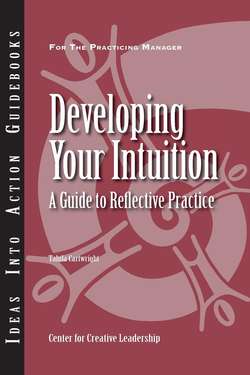Читать книгу Developing Your Intuition: A Guide to Reflective Practice - Talula Cartwright - Страница 9
На сайте Литреса книга снята с продажи.
ОглавлениеBringing It All Together
Reflective practices are what you might call whole-brain activities. They are different from analytical practices in that they draw on and help to develop a person’s intuition. Analytical activities are what were once called left-brain activities. (Because magnetic resonance imaging has challenged the assumption that this kind of thinking has a specific location in the brain, it’s now sometimes referred to as L-mode thinking.) When managers mistrust their intuition, it’s generally because their analytical, or L-mode, approach is rejecting it. Because they can’t articulate it or touch it or count it or name it, they don’t understand it—and so they don’t believe they can depend on it. Reflective practices are deliberate attempts to access R-mode thinking (formerly called right-brain thinking). R-mode thinking emphasizes such nonrational responses as metaphor and imagery. Reflective practices work by connecting the two modes of thinking, providing access to data, facts, values, experiences, hunches, analysis, evaluation, intuition, different perspectives, and feelings. That connection and access make reflection a whole-brain activity.
Before diving into activities that aim to connect the rational with the intuitive, it’s worthwhile to ask some basic questions: Where does intuition come from? Are there people who have it and people who don’t? Intuition has often been described as a person’s apprehending without having a full understanding of how or why. It’s a notion that has become so commonplace that it’s almost a cliché: the tough-guy private eye who has a gut feeling about a client, the gifted surgeon who follows her instincts to the heart of a disease, the corporate titan who plays a hunch and crushes the competition. These popular characterizations reinforce what we already know: in some way and at some times, people make decisions based on vague but powerful feelings. These aren’t the kinds of feelings we associate with emotion. Instead, they are feelings that we know more than we think we do, that we can anticipate an outcome—the feelings we commonly regard as intuition.
Young or inexperienced leaders are accustomed to relying on data and often don’t trust their inner voices and feelings, their hunches. Business schools train them to be analytical, and early in their careers organizations reward them for their analytical prowess. As they move up in an organization, however, another facet comes into play: experience. Intuition comes from this background of experiences and the lessons learned from them. It develops over years of trying different solutions and achieving good and bad results. Sometimes a person learns from an experience without being conscious of it or being able to articulate what has been learned. Reflective practices bring that background to the forefront. If a gut feeling is warning you not to do a certain thing and you do it anyway and it turns out badly, reflective practices can help you derive lessons from that experience. Those lessons in turn become influences for future decisions. Likewise, if following your hunch leads to good results, reflective practices will help you process that experience so that you draw out its lessons and, further, gain trust in your intuition.
